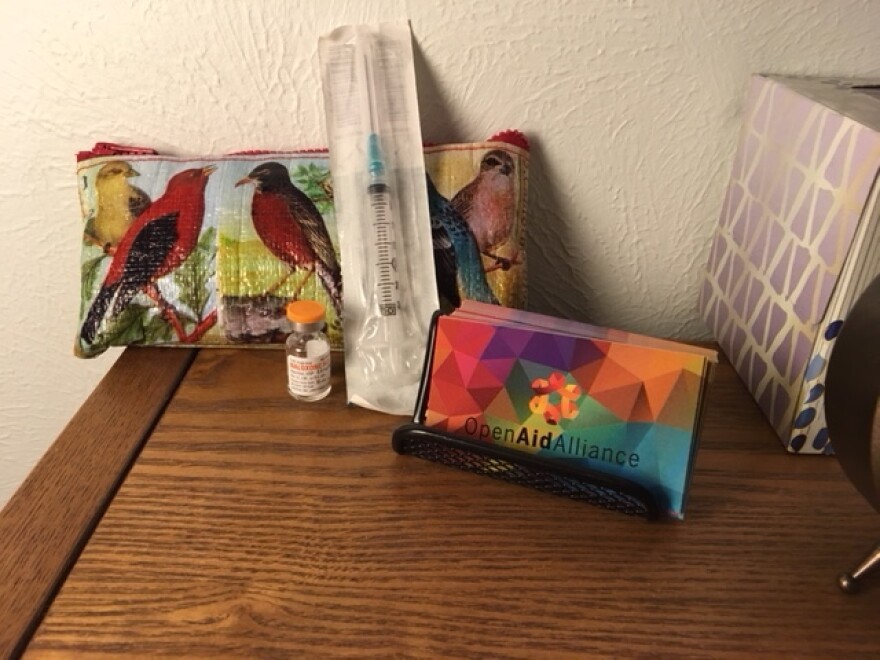A lifesaving drug that can reverse opioid overdoses is now more widely available in Montana. State health officials today highlighted that, thanks to a new law that went into effect in October.
The law, passed this spring with unanimous support, makes it possible for nearly anyone to get a prescription for the medication, called naloxone. That includes friends and family members of a person at risk of overdose, first responders, and other organizations like needle exchanges.
Naloxone stops opioid overdoses by blocking opiate receptors in the brain, restoring breathing and preventing death.
During a press conference Thursday morning in Helena, State Medical Officer Gregory Holzman said increasing access to naloxone is one step in addressing a national and statewide epidemic.
"Naloxone does not treat opioid disorder. But it gives people a second chance at life. And when we save those lives, because of the naloxone, we need not to quit there, but to help those persons move over into treatment, and toward recovery."
According to the state health department, Montana's overdose death rate from opioids is just below the national average of 5.5 per 100,000 residents. In 2009 and 2010 Montana saw 138 overdose deaths.
The Montana Medical Association says that Montana was one of only a handful of states that did not have naloxone access laws before the new law passed this spring Montana.
It is unclear how much naloxone is used in Montana and how that use will change under the new law.
The state health department has been issued a $100,000 federal grant to obtain naloxone for trained first responders. Through this grant, the Department of Health and Human Services will be able to track naloxone use going forward, and when it prevents overdose deaths in the state.
Missoula’s Amanda Reese believes expanding access to naloxone, the life-saving, opioid overdose reversal drug, boils down to common sense.
"People can’t get better if they're dead," she says.

Reese works at Missoula’s Open Aid Alliance, which operates a needle exchange and other health services.
"Many other states have had naloxone access laws for a while, so we're really excited that Montana is catching up," she says.
Reese estimates some 2,000 people have enrolled in Open Aid’s needle exchange. Some use it once and are never heard from again. Others get sober.
But for Missoulians who are currently injecting drugs like heroin, Reese says naloxone is literally a lifesaver.
"I had a gal not too long ago come in – it had been a few hours – but she had to give a friend some naloxone, and she wanted to come tell me about it. She was shaking still. She was really thankful, but it was pretty intense."
Montana’s new expanded-access naloxone law means anyone can legally purchase, carry and administer the drug – no prescription necessary. But programs like Open Aid Missoula are required to educate clients on opioid overdose recognition and response. And that includes a lesson on how to use naloxone. The most affordable versions of the drug can be injected right into muscle mass.
"You can hit it right in somebody's arm, or butt or thigh," Reese says. "You don't have to look for a vein. And then you wait about three minutes, which I always tell people is going to feel like an eternity when your friend or loved one is basically dead on the ground."

Reese says many people who are revived by naloxone immediately go into opiate withdrawal.
"It is the sickest you’ve ever been in your life. Think about having the flu, influenza, and then just times it by 10."
In other words, Reese disagrees with those who believe naloxone emboldens addicts by acting as a kind of security blanket. She says it is a measure of last resort.
When Montana’s expanded access naloxone law went into effect, Reese personally made the decision to always carry a dose. As an allergy sufferer, she also carries an EpiPen and says she would not hesitate to use it on someone else in need.
"And I kind of thought the same with naloxone. If I'm out in the community I think I'm in a unique position to recognize an opioid overdose. I would much rather have it and never need it, than the opposite."


